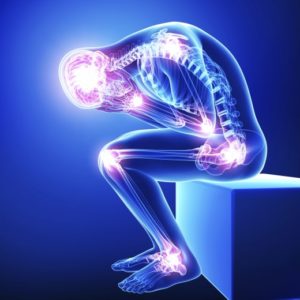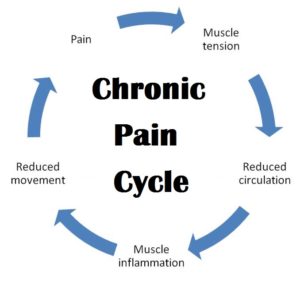
Acute pain Or Chronic Pain and Chiropractic Care
ACUTE VS CHRONIC PAIN. WHAT’S THE DIFFERENCE?

The pain you’re experiencing could actually be acute or chronic pain. The terms, acute and chronic, describe time frames and are not to be confused with pain quality or severity. There are, however, certain characteristics of the symptoms suffered that are common to one or the other.
Acute pain is usually provoked by a recent and specific injury or disease, and is typically associated with skeletal muscle spasm, short term inflammation, sudden restriction of movement (if involving a joint) and sympathetic nerve system activation. Its purpose is to motivate us to stop hurting ourselves and to take the appropriate steps to recover.
Acute pain has identifiable characteristics that can make diagnosis rather straight forward for practitioners. This type of pain is directly related to soft tissue damage such as a sprained ankle or a paper cut. Acute pain is known for its short duration, and it gradually resolves as the injured tissues heal. Although short in nature, the pain felt from this type of condition is relatively more sharp and severe than that of chronic pain.
Causes of acute pain can include:
- Recent traumatic injury (whiplash, falls etc)
- Burns or cuts
- Surgery or dental work
- Labour and childbirth
If the trauma was mild, pain relief and normal function can naturally occur within a few days of good self-management (rest, ice, heat, gentle stretching).
If the trauma or pain is more severe and/or looks to last longer, it is wise to have it checked. Poorly managed or ignored injuries have a much greater chance of becoming chronic requiring more management and a slower, potentially incomplete recovery.
Now for chronic pain. Again, this type of pain is not necessarily ‘severe’ pain. The severity of this pain is not recognised as being the same intensity as that of acute pain. Chronic pain is often related to as a ‘dull ache’ type of pain.
People who suffer chronic conditions can often report flare-ups from minimal efforts – i.e. drying hair, bending over to pick up something light etc. The cause does not match the outcome due to the deteriorating condition of the affected area or hypersensitivity of the central nervous system.
Chronic pain may indeed arise from any acute injury, repetitive strain (RSI) or even a long term lack of optimal function that has deteriorated over time. There can be other variables such as:
- Postural issues
- Lifestyle (smoking, poor diet, weight gain, sedentary, substance abuse)
- Ongoing illness
- Fatigue/ Insomnia
- Stress or mental health issues
- Arthritis
- Nerve damage (neuropathy)
- Allergies
- Long term medication use
Chronic pain can occur because of the changes to the nervous system’s sensitivity to registering a noxious (painful) stimulus. This means that your brain has begun to register pain too easily. There is also likely to be other contributing factors such as genetics, psychological wellbeing and previous episodes of pain or injury.
It is pain that outlasts the normal time of healing typically associated with a disease or injury. It may have no perceivable or natural (without treatment) end-point.
Considering this, chronic pain may be considered a ‘disease’ state.
Regardless of the type of pain you are experiencing, pain is the body’s physical sensation and warning signal telling us that attention is required to our health and wellbeing.
Treating the underlying conditions for chronic pain is vitally important. There are also a variety of options for treatment of chronic pain. .
Long term use of medication is not recommended as it does not improve function or long term relief.
Pain or Discomfort
- recurring and/or persisting 2+ days
- not related to increased exercise or minor injury
- referred or radiating
Recurring stiffness and/or reducing flexibility
Postural issues
There is Hope
Exercise, posture, mobility, regularly breaks from sitting/work and good nutrition is very important in maintaining good spinal health. So too is appropriate treatment and check-ups.
Ignoring/ masking pain is not only risky to your health but can be very expensive in the long run.
Yeronga Chiropractic provides expert and thorough examination and management for back pain, sciatica (pinched nerve causing leg pain), disc pain (“slipped” disc, herniated disc, and bulging disc), arthritis, repetitive strain injuries, scoliosis, acute and chronic pain. Massage, exercise prescription, ergonomic advice and referral to other modalities for investigation or treatment will be discussed when appropriate. Our patients enjoy high satisfaction levels in not just relief from pain, but better function as well.
Get it diagnosed
Get it treated
Get proactive to get the best results!
We are here to help!


